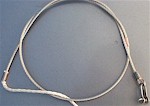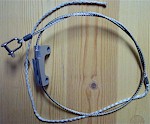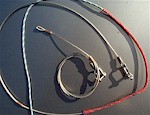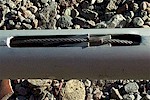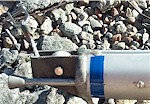Updated 3 September, 2001
It shouldn't be so complicated, all it does is keep the mainsail up, but it turns out there are some different ideas on main halyards.
No Main Halyard
Some people argue that removing the weight of the main halyard, and reducing the compression on the mast should make you (imperceptibly) faster, and that the sail should be tied or otherwise fastened directly to the top of the mast. This will require rolling the boat over to hoist the main, and again to take it down. The simplest way is to simply tie the mainsail headboard to the pin (you remove the sheave but keep the pin). A slight refinement on this is to have a shackle on a very short piece of wire, permanently fastened to the head casting. This is more elegant than tying a knot each time, and keeps the headboard at exactly the height that you intended. It is probably lower drag (windage) than the line.
The people doing this must feel quite strong after a long hard race to be able to roll the boat over to unfasten the mainsail, and do not appear to be concerned that they cannot lower the mainsail on the water, without capsizing the boat.
Halyard Lock
Lots of 505s use halyard locks. A wire halyard is used to pull the mainsail up, but rather than fastening the halyard at the bottom of the mast, a ball swaged onto the wire is cleverly jammed into a halyard lock, normally installed in the mast near the top. You have added the weight of the halyard and the halyard lock, but you still reduce the compression on the mast, and the headboard will be held at the correct height. Halyard stretch or mast bend will not cause the sail to move down from the band at all.
The halyard locks are a little work to install, and must be properly lined up. If they are not properly lined up, or are worn, you will find it difficult or impossible to get the ball to lock in the halyard lock, and will end up rolling the boat over.
A neat variation on this system is using a piece of wire just between the shackle on the sail headboard and the swaged on ball, and splicing that wire to a light line halyard that goes the rest of the way down the mast. This saves weight compared to the all wire halyard system.
Waterat Style Clip
The standard Waterat system has a wire halyard with a nicopressed soft eye at the bottom where the light halyard tail is attached to the wire halyard. You hoist up the main, pull the wire loop out of the mast - it turns around a Harken thru-deck through the web at the bottom of the mast - and jam the nicopress sleeve in a clip fastened above the Harken block, on the back of the mast. If you have the wire length right, and the clip doesn't move, you know that you have hoisted the sail exactly to the black band. It is also easy to pull the sail up, and wire does not stretch noticeably.
The disadvantages of this system are that you carry the weight of the halyard wire (typically 3/32"), and that the wire eventually wears next to the nicopress sleeve, where it goes through the slot in the halyard clip. When the wire fails, the main comes down, and you either sail in under jib only, or dump the boat and tie the sail to the top of the mast.
Parker System Using a Hook Plate
Lots of 505 masts were rigged with a wire halyard and a large soft eye at the end. To make life a little more challenging, the halyard tail emerged from the mast through a hole, without a turning block. You would have to figure out how to pull down on the halyard tail where it emerged from the mast (which usually involved lying in the boat and pulling a few inches at a time of halyard...). When you finally got the soft eye out of the mast, you hooked it over a multi-hook plate that presumably allowed you to pull the halyard tighter to compensate for lots of bend and lots of cunningham. I hate this system!
All Line Halyard
With lines like Kevlar and Spectra available, light weight, low stretch alternatives to wire halyards become viable. The simplest variation is a halyard line that is tied to the headboard (no shackle saves weight) and emerges from a slot in the side of the mast at the bottom. It is lead through a small block lower down on the mast, and can be put into a cleat, or two cleats between the slot and the block. Basically, you haul up the sail and make sure the line is cleated in the two Clam Cleats. If you are worried about wear in the line at the top, you cut off a few inches and keep using it.
This is lighter than wire, and allows you to adjust the mainsail height to compensate for mast bend and cunningham.
The disadvantages are that eventually the line and or cleats wear, and the halyard starts to slip. You could simply replace the line and cleats when this starts to happen.
2:1 Halyard
From Peter Alarie regarding the "2:1" main halyard system that Zani/Alarie and Trotman/Mills used at the '98 Worlds:
" We use Yale Maxibraid in a 3mm or so size. Drill a hole in the top of the masthead and dead end the hal there. The line then passes through a shackle on the headboard and back up through the masthead sheave and down to a simple clam or horn cleat. I like this more for its simplicity than its compression gains."
